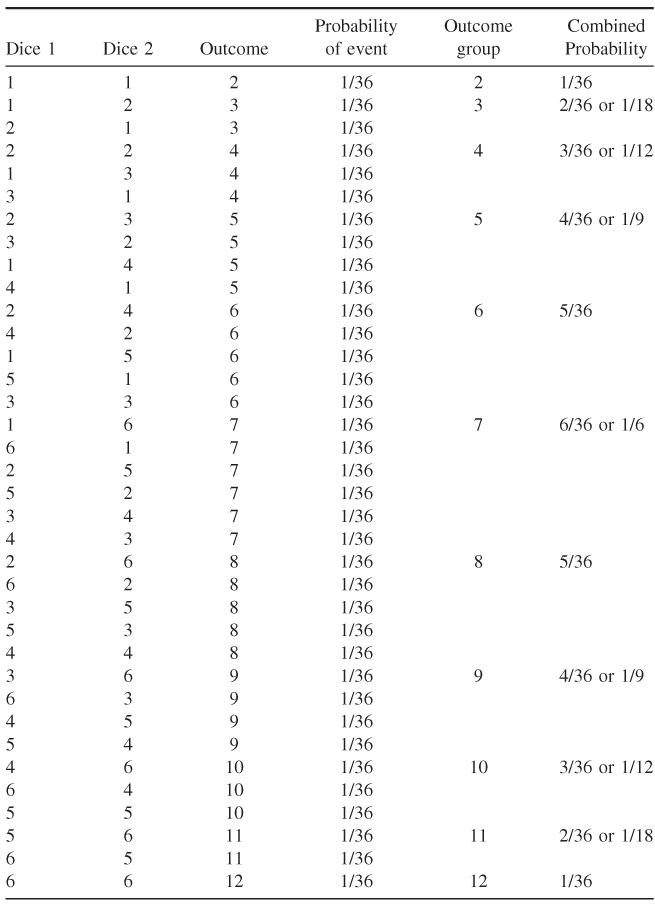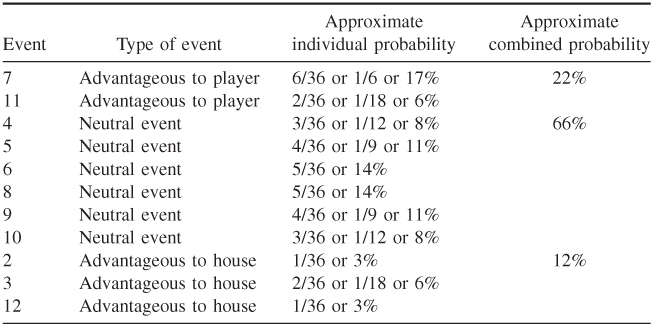7.1 Introduction
Probability theory is thought to have evolved around 1654, with the French mathematicians Blaise Pascal and Pierre de Fermat. The theory was created in order to help gamblers in games of chance, such as “Roulette,” “Dice,” “Craps,” and “Cards” (1). This chapter provides only a brief overview of the concepts of probability. The readers are referred to a text on probability and statistics for an in-depth discussion.
Probability theory is an integral part of risk assessment. In fact, they go hand in hand. Whether it is gambling at a casino or the stock market or gambling with one's life on the freeway, actions are performed by people based on some knowledge or perception of the probability of a successful/unsuccessful outcome. Many times risks are taken and successful outcomes occur, and the common method of explaining this is that the person was lucky or conversely people will say they or someone else was unlucky if a negative outcome occurred. Luck, of course, is defined as a chance happening. Almost everyone and every culture have some feeling or perception of luck. Most people entering a casino hope they are lucky. They want a successful outcome. If they are successful then they were lucky, if not, well Karma or bad luck or some other supernatural force caused them to be unlucky. This superstitious view of luck or chance is different than viewing events based on the probability they will occur.
All games of chance (luck) are based on some predefined probability of success and failure. All betting games at a casino have a house edge. Card games, for instance, Blackjack or 21 has a house edge of between 0.17 and 0.44% (2). A card game such as “Let it Ride,” called a carnival game, has a house edge of approximately 3.5%. Slot machines and other computer-based gambling devices can have a house edge of 10%. This house edge can be governed by state law.
The dice game Craps is a good way of explaining the very basic principles of probability and risk. In the game of Craps, a participant rolls two dice. He/she is called the thrower. The casino ensures that each die is fair. Meaning, the probability of any of the numbers on the die coming up are equal. The die has six sides and, as we all know, is numbered from one (1) to six (6). If the die is loaded or one side has a higher probability of coming up then the casino can be at a disadvantage. The Craps table is designed so the dice tumble when they hit the table. This ensures randomness. Randomness plays in favor of the casino. Throwers could manipulate the dice by sliding them if the table did not contribute to the tumbling of the dice.
When a player walks up to a Craps table, they place a bet. There are many bets that can be placed. Assume the player walks up to the table when there is no number that is “On.” This will be explained soon. The player lays down a bet of $10 on the pass line. At this point the player is betting that one of two events will occur. Either a seven (7) or an eleven (11) will be thrown and the player will be paid even money ($10) or that the thrower will throw a four (4), five (5), six (6), eight (8), nine (9), or ten (10). If the thrower throws one of these numbers, no money is exchanged and a point number is determined. The point number then becomes the “On” number. If the thrower throws a two (2), three (3), or twelve (12), the player loses his/her bet. This is a “Craps.” The thrower, whether it's our player or it's another player, throws the dice. The probabilities of the 36 combinations of numbers coming up are shown in Table 7.1. These probabilities or odds cannot be changed if the dice are fair and the table provides a surface that ensures the dice will tumble.
Table 7.1 Dice Probabilities

Table 7.2 shows the probabilities of the possible events at this point in the game. For the simulation, assume on the first throw a six (6) comes up. This, as explained above, then becomes the point number, and it is said to be “On.” The probability that a six (6) would come up is 5/36 or approximately 14%. The probability that either a seven (7) or an eleven (11) would come up is approximately 22%. The probability that a two (2), three (3), or twelve (12) would come up is approximately 12%.
Table 7.2 Probabilities of Dice Events

So, what was the risk the player was taking? He risked his bet of $10. He had a 12% probability of losing his $10. He had an approximately 22% probability of winning $10. There was an approximately 66% probability of a neutral event. Was there a risk beyond this bet? No, the player can make a decision at this point to walk away from the table. However, our player chooses to play one more time.
There are several betting options that can now occur, such as placing a side bet on the point number behind the pass line, betting on other numbers, and so on. Our player keeps his simple bet on the pass line. He is now betting that a six (6) will come up. Table 7.3 shows the probabilities of the possible events that our player is possibly subjected to. At this point, the house has a 3% edge. To make a long story short, at this point, a seven (7) is thrown and the player loses his $10.
Table 7.3 Probabilities of Second Round

